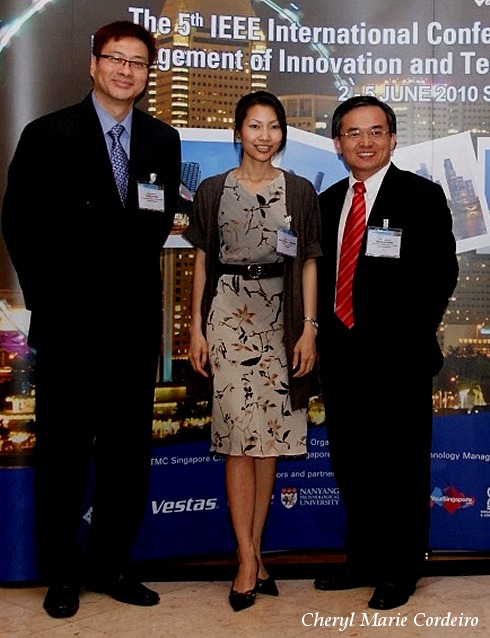From left to right Keynote speaker, Professor Philip Phan, Dr. Cheryl Marie Cordeiro and Keynote speaker, Professor Michael Song, ICMIT 2010 in Singapore
Photo: Courtesy of ICMIT 2010
Behind the short and cryptic ICMIT stands the full title of the IEEE International Conference on Management of Innovation and Technology 2-5 June 2010. Originally a Singaporean initiative, this conference was now held for its fifth time.
Since my academic interest revolves much around Knowledge Management, Communication and Information Technology, I was happy to find towards the end of last year that a paper I had submitted to this conference had been accepted, and not only that but I was also invited to take a more active role in the conference by being part of the scientific review committee and indeed, actually chairing one of the sessions.
Even if I have spent my last ten years in Sweden, I did grow up in Singapore and spent my postgraduate years at the National University of Singapore (NUS) and the Nanyang Technological University of Singapore (NTU) respectively.
So this conference was a happy reunion of sorts since the organizers of this conference were mainly from NUS and NTU, so it gave me a chance to meet with several former professors, who were also my mentors. In particular a warm thank you goes to Dr. Chai Kah Hin (NUS) and Dr. Ravi Sharma (NTU) for a conference well organized, and to Dr. Chris Khoo Soo Guan (NTU) who besides a most impressive tour around the vast NTU campus also showed us the best new dessert and ice cream parlors in the area.
Conference themes
The main theme to this year’s ICMIT conference was Management of Innovation and Technology in its widest sense. My point and contribution was to discuss that technology when managed, packaged and sold as in whole industrial complexes for example, would fail if not accompanied by the tacit knowledge that is needed to make it work. My point was illustrated from the perspective of Swedish managers working in Swedish companies in Singapore.
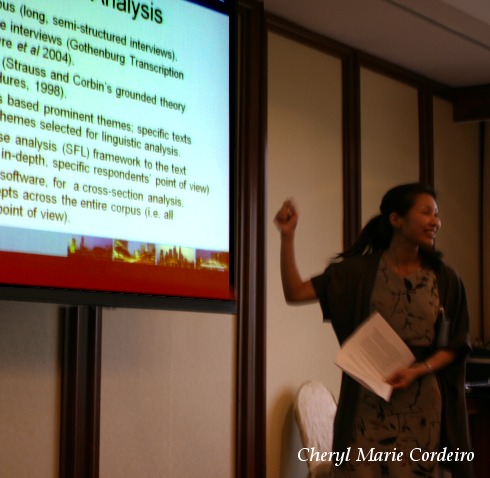
My paper was presented under Knowledge Management (1), 4/6/2010 13:30-15:00, Room: Jupiter, Chairs: Cheryl Marie Cordeiro and Ying Hsun Hung
As an example, a bicycle in a box however neatly packaged and sent somewhere, would still need someone to teach one how to use it, to be of any use at all. And how this tacit (implicit) knowledge transfer – by definition not possible to codify – could be investigated and assessed by the use of language.
When keeping up is not enough
What struck me when we circled down for landing in Singapore Airline’s (SIA) Boeing 777-212ER was how fast Singapore changes. Every time I come back, the landscape changes.

The new ION shopping mall that opened July 2009 at Orchard Road, brings together ”the world’s best brands’ flagship, concept and lifestyle stores within one development, with four levels above ground and four levels below – totaling 66,000 square meters of retail space.”
There is however, a price to pay for Singaporeans with these speedy changes. There are so many memory lanes that are just not there anymore to be walked and the financial and architectural development is done in such a rush, at such a breakneck speed, that it washes clean a sense of rootedness for Singaporeans to its land. Still, Singapore is indeed one of the major financial and administrative centers in South East Asia, a character trait that impresses upon visitors with the current architecture of the heart of the Central Business District. The goal of Singapore is to make it to the lead, and remain there.
Changi Airport
The first of those large scale and very visible efforts in innovative architecture and technology that one gets in contact with immediately after landing is Singapore’s Changi Airport itself. It handles about 4,300 weekly flights, operated by 80 airlines to 130 cities in 59 countries. About 13,000 people are employed at the airport and its new terminal 3 – hailed as an architectural masterpiece at its opening a few years ago in 2008 – added by itself an additional capacity of 22 million passengers per year. Terminal 3 is currently solely dedicated to handling SIA flights.

Changi Airport Terminal 3 baggage collection point.
The Green Wall (right) spans 300 m and comprises 25 species of climbing plants.
The first day of the conference – June 2, 2010
The conference spanned all in all four days including workshops and visits to places of interest.
At this conference we were not invited to yet another mundane conference meeting but rather to an experience of the very theme of the conference as reflected in the places we were invited to see, to experience the country, and to experience the heartbeat of Singaporeans, gaining insight into what drives this country forward and ultimately why this conference was called together here in the first place.
The first day offered besides delegate registration and welcome reception a much appreciated pre-conference workshop on submitting scientific articles from a publisher’s point of view and a few pre-conference tours of which the most significant went to the new engineering and architectural feat, the Marina Barrage.
Good food is however never far from the mind of Singaporeans so next stop was a visit to Singapore’s oldest hawker center, Lau Pa Sat with a variety of local food and, to the Night Safari.
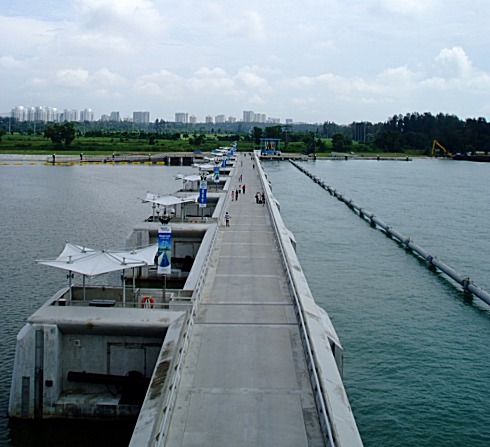
The new Marina Barrage. A new sweet water reservoir and flood control project which magnitude is hard to grasp even for the Singaporeans themselves. The entire Marina Bay, the Singapore River with the Boat Quay area and the old waterfront harbour has now been turned into an artificial inland lake.
Photo: Wikipedia
A visit to Singapore’s new Marina Barrage
In a country with no natural resources of its own except its location and its population, it is not surprising to observe the theme of the ICMIT 2010 conference distinctly reflected in the changing landscape of Singapore.
After a massive land reclamation project that has taken place over several decades, the entire entrance of the Singapore River has been moved several kilometers out and has now been shut off by a 350 meters wide dam. This dam will now turn the entire river and bay area into a pure sweet water reservoir, changing the face of Singapore forever.
A better example of local Management of Innovation and Technology is hard to imagine.
The conference location at the Furama Riverfront Hotel
The conference itself was held at the Furama Riverfront Hotel, a significant location since it’s just a bit up the old Singapore River where old Singapore was once founded to serve as a free port to support the South East Asian trade, and its connection to the western hemisphere’s trade and industry.

The conference itself was held at the Furama Riverfront Hotel at Havelock Road, just a bit up the old Singapore River.
If we then look downstream towards the Asian Civilizations Museum (ACM), where the conference dinner was held, and where Sir Stamford Raffles actually landed in 1819 to the right in this picture, we will have this view.

Singapore River looking downstream. Conference dinner location to the left, old Battery Point (Fullerton Hotel) front, Central Financial District and Boat Quay to the right. Straight ahead at the horizon the Millennia Tower, north of the Marina Bay.
In front of the ACM but on the other side of the river is the Fullerton Hotel, originally a historic colonial building with red roof and columns, standing right on top of the former Battery Point, where the British almost immediately set up a small fortress to defend the young settlement, just next to the river entrance. To the right of the Fullerton/Battery Point and stretching south along the coast was the old harbour. Just inside of that harbor was ”China Town”, still there today. To the immediate right is still, and very much so, the Central Finance District of Singapore and the Boat Quay, where original shop houses and wharves lined the bank of the river. Straight ahead the river outlet overlooks the Marina Bay, now turned into an artificial lake of enormous proportions.
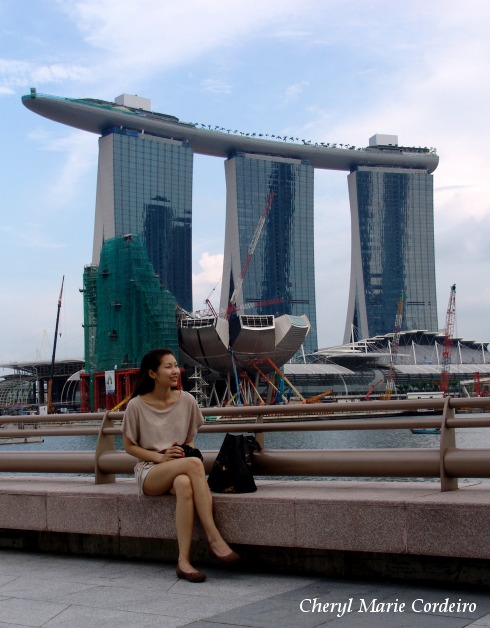
In the background the ’Integrated Resort’ Marina Bay Sands, located near the Marina Bay, as seen from the Esplanade outside the Oriental Hotel.
The remarkable structure with what looks like a curved boat atop, is one of my favourite architectural features of this week’s edition of Singapore. It is the Marina Bay Sands, one of Singapore’s two ”Integrated Resorts” (IR) widely published by the poker toting community worldwide as a casino. But, this gives a misleading impression of the thoughts behind giving this project the best and most expensive premium location so far ever made available in Singapore. No doubt this will be a casino too, but better yet is to conceive Marina Bay Sands as one of the world’s most spectacular conference centers, with the gambling franchise just tossed in to foot the enormous construction bill of 42 billion SEK (or 5.3 Billion USD / 4.2 Billion EURO).
These three new hotel towers offer 2,500 rooms and is topped by an extraordinary sky park with a swimming pool 200 meters above ground. Here are ‘floating’ crystal pavilions, a lotus-inspired Museum, retail stores featuring cutting-edge labels and international luxury brands, trendy Celebrity Chef restaurants, theaters and night clubs. Business visitors will also enjoy the extensive Meetings, Incentives, Conventions and Exhibitions (MICE) facilities featuring state-of-the-art technology, highly flexible exhibition halls and a convention centre that can host over 45,000 delegates, 2,000 exhibition booths and 250 meeting rooms and – a Las Vegas-style casino.
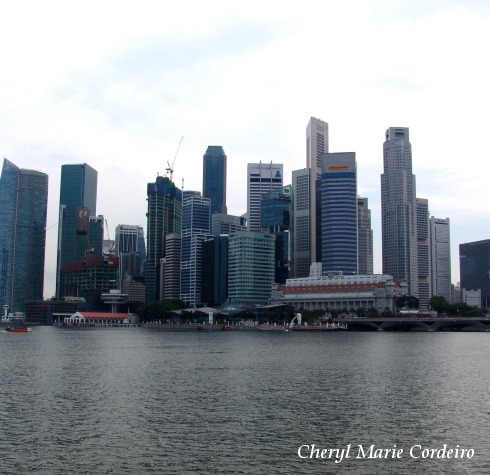
On each side of the Marina Bay, on one side the new ”Integrated Resort” Marina Bay Sands facing on the other side, the Central Financial District.
All this is located at the Marina Bay, immediately facing the Central Business District and both located a mere 20-minute ride from Singapore’s Changi Airport. After a quick peek at the City Hall exhibition room on future Singapore, an architectural model shows that the plan is in fact to connect the Bay Sands with the Financial District in a wide semi-circle of new high rises, utilizing the newly reclaimed land out towards the Marina Barrage, I would say that all the pieces are starting to fit together pretty neatly.
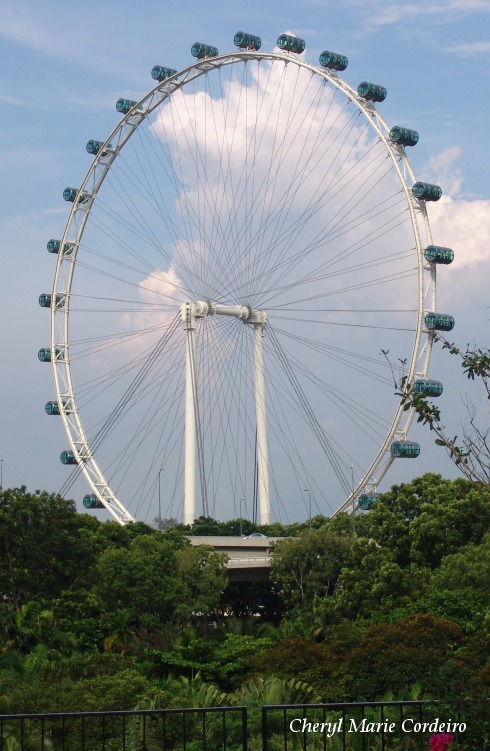
The Singapore Flyer.
The projects I have mentioned here, I see as all part of a plan to support Singapore’s efforts to remain the major business and financial hub in the region.
Just next to the Marina Bay Sands is the Singapore Flyer, a large observation wheel. Located at the southern tip of the Marina Centre, its presence appears as a lighthearted show off of technological brilliance. The Flyer is 150m in diameter and has a total height of 165m, reaching taller than the Star of Nanchang and the London Eye, offering panoramic views of not only Singapore’s city center but beyond it, including the Indonesian islands of Batam and Bintan as well as Johor, Malaysia.
The conference day 2-3
Of about 430 submitted papers, around 300 were read during the ICMIT2010 conference. At the end of the third day of the event or second day of the actual conference, a much appreciated conference banquet was held at the Asian Civilizations Museum. A river tour transport was offered from the Furama Riverfront Hotel that ended at the museum and at Raffles’ Landing Site at the Museum.
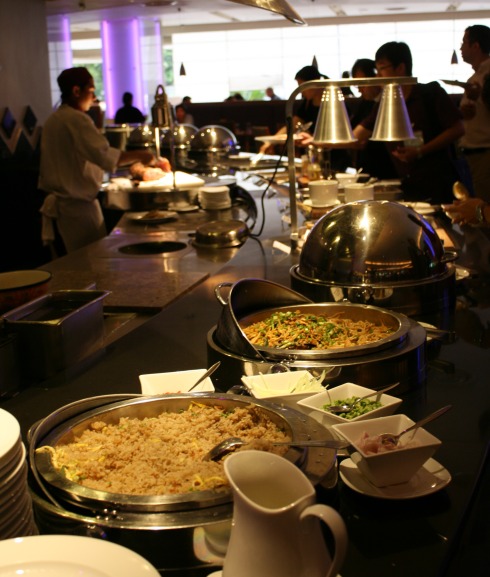
Conference lunch buffet at Furama Riverfront Hotel
Post-conference symposium day 4
To round off this interesting conference a post-conference symposium was planned to be held at the Singapore Management University (SMU). Eventually this was changed to a tour of SMU/NTU/NUS. This was largely a bus tour with about 35 participants and completed in half-day. It started with SMU at 9am, then to NTU (break for coffee), and to NUS (end with lunch).
More than a conference
In a famous speech the founding father of the modern Singapore, former Prime Minister and Minister Mentor Lee Kuan Yew once said that a tiger that felt successful and happy could easily become fat and lazy, and that the Singaporeans could not ever afford to go that way. As such, this conference when put into its proper context, shows that Singapore is keeping its spirits high and its people will not likely forget the valuable words of MM Lee.
At the end of the day, the ICMIT is more than a conference. It has over the years developed into a meeting place for a group of concerned researchers and scientists, who all delve into the inner workings of the strategic management of technology and innovation, with what moves our society forward in terms of increased standards of living intertwined with sustainability and environmental consciousness in its widest sense.
Looking back over the years that this conference has been held, it is obvious how the themes have developed from its basics around hardcore technical engineering and modestly soft management questions, to topics that today incorporate concepts on increased globalization, environmental concerns, the importance of the emerging markets and the more advanced models of management that have been facilitated by the introduction and more advanced uses of information technology.
A final thought
As an alumni of both the organizing universities I am proud of in some small way being a part of all this and if I were to finalize this modest report with something, I think that the field where I am currently working, which is knowledge transfer, might well be one of the areas this conference will move towards having more of in the future.
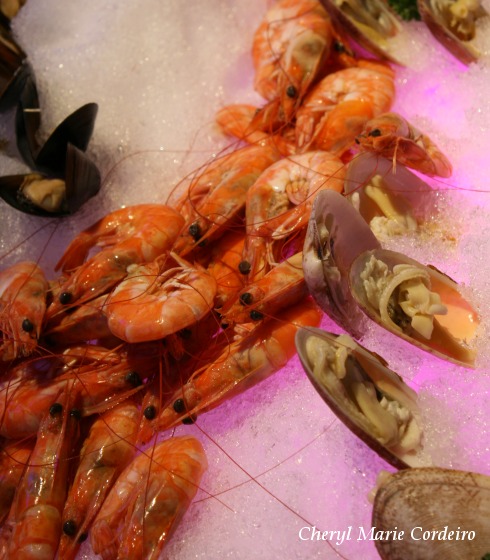
Seafood at conference lunch buffet.
Finally, academic interest aside, I think that if the next conference is able to match this one in terms of places of interest to visit – and food – that will be a perfectly good enough reason to see you all again at the ICMIT 2012.
